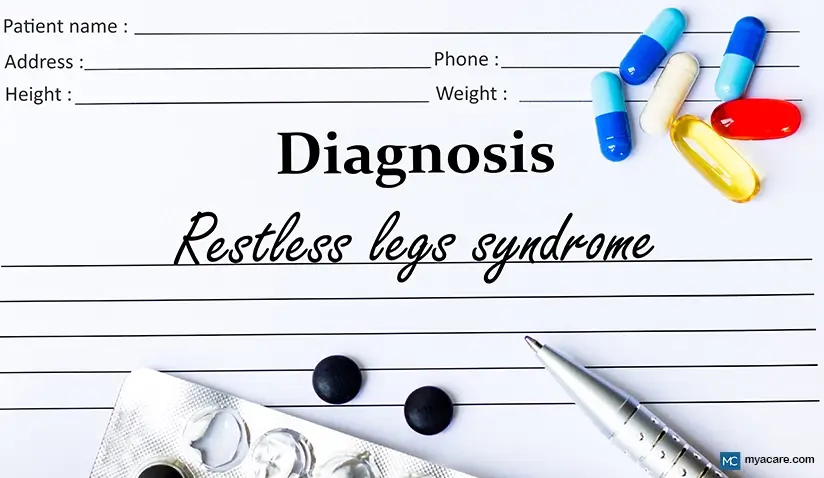Restless Legs Syndrome - Causes, Diagnosis, Treatment, and Latest Research

Medically Reviewed and Updated by Dr. Rae Osborn, Ph.D. - August 19, 2024
Restless Legs Syndrome (RLS), or Willis-Ekbom Disease, involves the nervous system, causing an irresistible urge to move the legs. RLS has an estimated prevalence of 5-10% in the US population, with women being twice as likely to develop the condition as men. Older adults have a higher likelihood of developing RLS, yet it can also occur in people at younger ages.[1]
This article sheds light on the characteristic features of RLS, its impact, types, causes, diagnosis, treatment options, and the latest advancements in treating the condition.
What is Restless Leg Syndrome?
Restless Leg Syndrome is a condition affecting the nervous system that leads to somewhat unbearable sensations in the legs, often portrayed as a creeping, crawling, or tingling feeling. This sensation usually accompanies an irresistible urge to move the legs, which provides temporary relief. The symptoms of RLS typically occur at night, making it difficult for individuals to get to sleep and causing interrupted sleep or sleep deprivation.
The impact of RLS can significantly affect an individual's quality of life and daily activities. The lack of sleep caused by RLS culminates in fatigue, irritability, and difficulty concentrating. Work performance and relationships may potentially suffer as well.
Symptoms of RLS
The primary symptom of RLS is an uncomfortable sensation in the legs, accompanied by an irresistible urge to move them. Other symptoms include:
- A tingling, crawling, or creeping sensation that causes discomfort in the legs. It may also cause itching, burning, or aching sensations in the legs.
- Restlessness that worsens with rest and improves with movement.
- Involuntary leg movements, known as periodic limb movements, which can disrupt sleep.
- Symptoms occur at night for up to an hour or more at a time, making it difficult to fall asleep or stay asleep.
Can Other Body Parts Be Affected by Restless Legs?
RLS only manifests in the legs. Those with RLS sometimes have periodic limb movement (PLM), which refers to involuntary leg jerks or twitches during sleep, typically every 20-40 seconds. This can occur in other body parts, such as the arms, torso, and face. PLM is milder, as it does not necessarily wake the patient up during the night. It is often noticed by the patient's partner.[2]
Types and Causes of RLS
While there are no currently established causes for RLS, it may have genetic origins or be influenced by medical conditions and medications.
There are two types of RLS: primary and secondary.[3]
- Primary RLS influences the central nervous system and appears to have a genetic component for 25-75% of patients.
- An underlying medical condition or medicine is the cause of secondary RLS.
Tricyclic antidepressants (TCAs), beta-blockers, selective serotonin reuptake inhibitors (SSRIs), serotonin-norepinephrine reuptake inhibitors (SNRIs), antidopaminergic drugs (such as neuroleptics), and lithium are medications associated with RLS. Health conditions that can cause RLS include:
- Advanced chronic kidney disease and kidney failure
- Diabetes type 2
- Inflammatory rheumatic disease
- Venous insufficiency
- Peripheral neuropathy and nerve damage
- Amyloidosis
- Lumbosacral radiculopathy (a lower back nerve disorder)
- Fibromyalgia
- Celiac disease
- Parkinson's disease
Risk Factors and Triggers
Aside from genetics, health conditions, and medications thought to contribute, other risk factors that can also trigger RLS include:
- Iron deficiency
- Folate or magnesium deficiency
- Alcohol
- Caffeine
- Pregnancy
- Sleep deprivation
- Fatigue
These factors can also cause RLS to flare up or get worse.
Restless Leg Syndrome and Pregnancy
Pregnancy is a common trigger for RLS, with up to a third of pregnant women experiencing symptoms. The hormonal changes and elevated blood volume during pregnancy can contribute to developing or worsening RLS. However, symptoms usually resolve up to a few weeks after giving birth.
Developing the condition during pregnancy imparts a four-fold risk of contracting chronic RLS.
Advanced Kidney Disease
There is a link between end-stage renal disease and restless leg syndrome, which is present in 25-50% of kidney disease patients undergoing hemodialysis. High levels of blood phosphorus (hyperphosphatemia) and anxiety may contribute to worsening RLS in renal disease patients. Kidney transplantation can help these patients resolve their RLS symptoms.
Parkinson's Disease
Given the prevalence of RLS affecting around 4-10% of the US adult population, it is evident that the majority of individuals with Restless Leg Syndrome (RLS) do not develop Parkinson's Disease (PD). However, there are conflicting studies suggesting that there is a possibility RLS could heighten the risk of developing PD in the future.[4]
Research suggests that dopamine levels may play a role in the development of RLS, with high blood dopamine levels in those with RLS.[5] Dopaminergic medications that treat those with Parkinson's disease are the primary treatment for RLS, able to ease symptoms in a large percentage of cases
Complications of RLS
While RLS itself is not life-threatening, it can lead to various complications, including:
- Sleep deprivation and fatigue
- Difficulty concentrating and irritability
- Depression and anxiety
- Decreased quality of life
- Increased risk of cardiovascular disease[6]
Diagnosis of RLS
RLS is an under-diagnosed condition. Diagnosing RLS can be challenging, as no specific test exists for the condition.
A doctor typically diagnoses RLS based on a physical exam, medical history, and characteristic symptoms. They can also request blood tests to rule out iron deficiency or other underlying medical conditions such as kidney disease or diabetes.[7]
Sleep tests are necessary if severe sleep disruption is present. There are two main sleep tests: a suggested immobilization test and polysomnography. An immobilization test monitors leg movements while the patient lies down. A polysomnography measures breathing patterns, brain waves, and the heartbeat during sleep and can diagnose PLM.
Treatment Options for RLS
Although there is no known cure for RLS, there are a number of treatment options that can enhance the quality of life and aid with symptom management. These include lifestyle modifications, home remedies, and medications.
Lifestyle Modifications
Positive lifestyle changes that can help manage RLS symptoms include[8]:
- Regular exercise, particularly in the evening
- Avoiding caffeine, alcohol, and tobacco
- Establishing a regular sleep schedule
- Taking warm baths or using heating pads on the legs
- Taking a hot or cold shower before bed
- Applying a warm or cold compress to the legs
- Stretching or massaging the legs
- Using a foot wrap or compression socks
- Practicing relaxation techniques, such as yoga or meditation
What Foods Make Restless Legs Worse?
Certain foods and drinks can worsen RLS symptoms, including:
- Caffeine
- Alcohol
- Spicy foods
- High-fat foods
- Processed foods
- Foods high in sugar
Foods and Supplementations That Improve RLS
Effect of Bananas on RLS: Bananas are a good source of potassium, which is essential for muscle function[9]. Some individuals with RLS have reported that eating a banana before bed can help reduce symptoms. However, more research is needed to confirm this claim.
Vitamin D and RLS: Vitamin D deficiency has been linked to RLS, and some studies have shown that vitamin D supplementation can improve symptoms. One review concluded that the prevalence of vitamin D deficiency is high enough amongst those with RLS, and having their levels checked and corrected may be worthwhile, irrespective of their condition.
More research is needed to determine the exact role of vitamin D in RLS.
Iron Supplementation: Iron deficiency is prevalent in a subset of RLS patients, and iron supplementation may improve symptoms in these individuals[10]. However, iron supplementation should only be done under the guidance of a doctor, as too much iron can be harmful.
Medications
In more severe cases, medications may assist in the management of RLS symptoms[11]. These include:
- Dopamine agonists enhance brain dopamine levels and can help reduce symptoms.[12]
- Benzodiazepines which can help improve sleep.
- Anticonvulsants, can help reduce symptoms and improve sleep.
- Opioids, are only prescribed in severe cases.
In a 2013 study, a 6-month exercise training program proved to be as effective as a dopamine agonist for treating RLS in hemodialysis patients. Exercise may be a potent complementary therapy or alternative for individuals who do not respond to medications or other treatments.
Neurostimulation
Neurostimulation is a non-invasive treatment that uses electrical impulses that stimulate the nerves in the legs. This can help reduce RLS symptoms and improve sleep, especially for patients who do not respond to medications and lifestyle interventions.[13]
Latest Advancements in RLS Treatment
Researchers are continually exploring new treatment possibilities for RLS, including gene therapy, non-invasive brain stimulation, and targeted drug development. These advancements promise to provide more effective and targeted treatment options for individuals with RLS.
Some active research areas include[14]:
- Brain signaling changes in RLS, particularly dopamine transmission in the basal ganglia and their genetic correlates.
- Genetic and epigenetic alterations associated with iron deficiency during pregnancy, infancy, and childhood and how these impact RLS development.
- The transportation of iron into the brain as a basis of new treatment options for RLS.
- The use of advanced MRI to study brain chemical changes in individuals with RLS aids in the development of new research models for correcting overactive arousal.
Wearable TOMAC Neurostimulation Device
One of the latest breakthroughs is testing wearable neurostimulation devices for RLS treatment during sleep, such as the tonic motor activation (TOMAC) device.
The TOMAC is a wearable, non-invasive peripheral nerve stimulation device used to treat medication-resistant restless legs syndrome (RLS). The TOMAC system consists of two therapy units worn externally and bilaterally over the lower leg's peroneal nerve at the head of the fibula bone. Each therapy unit includes a charge port, intensity lights, a status light, and control buttons.
It electrically stimulates the peroneal nerve, activating the tibialis anterior muscle. This stimulation mimics the effects of voluntary leg movements, which are known to relieve RLS symptoms but in a way that allows people to sleep. In a clinical trial, TOMAC was found to be safe and effective for reducing RLS symptoms.
Stellate Ganglion Block
Another new treatment for restless leg syndrome (RLS) is a stellate ganglion block (SGB). A minimally invasive technique called SGB entails injecting an anesthetic drug near the stellate ganglion, a group of nerves in the neck. This procedure typically treats pain, stress, and sleep disorders. Studies report that SGB may effectively treat RLS, especially in patients with severe comorbidities[15].
Conclusion
Restless Legs Syndrome, or Willis-Ekbom Disease, is a neurological condition that involves the nervous system and leads to an irresistible urge to move the legs. While a cure for RLS remains elusive, there are several treatment options capable of managing symptoms and improving quality of life. With the latest advancements in RLS treatment, there is hope for more effective and targeted treatment options.
To search for the best Neurology Doctors and Healthcare Providers worldwide, please use the Mya Care search engine.
To search for the best healthcare providers worldwide, please use the Mya Care search engine.
The Mya Care Editorial Team comprises medical doctors and qualified professionals with a background in healthcare, dedicated to delivering trustworthy, evidence-based health content.
Our team draws on authoritative sources, including systematic reviews published in top-tier medical journals, the latest academic and professional books by renowned experts, and official guidelines from authoritative global health organizations. This rigorous process ensures every article reflects current medical standards and is regularly updated to include the latest healthcare insights.

Dr. Rae Osborn has a Ph.D. in Biology from the University of Texas at Arlington. She was a tenured Associate Professor of Biology at Northwestern State University, where she taught many courses to Pre-nursing and Pre-medical students. She has written extensively on medical conditions and healthy lifestyle topics, including nutrition. She is from South Africa but lived and taught in the United States for 18 years.
Sources:
Featured Blogs



